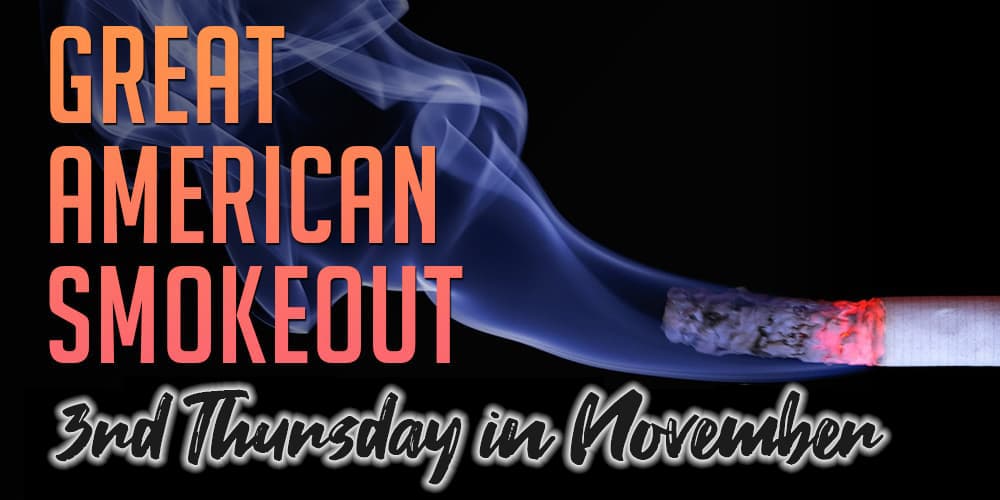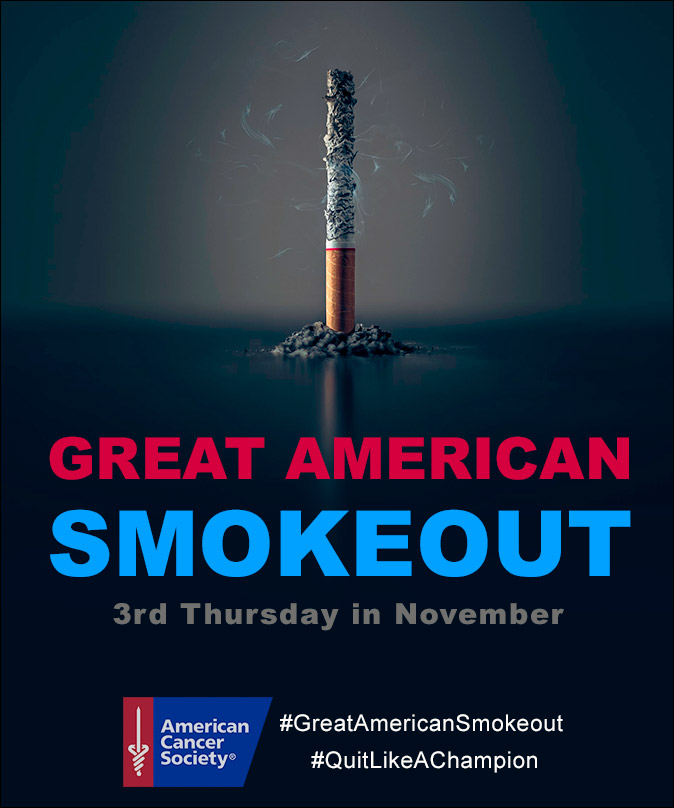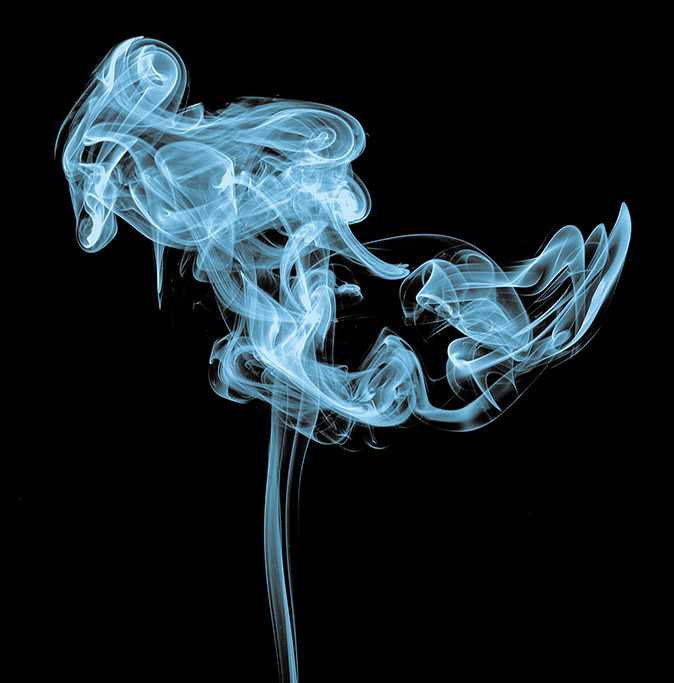
Join together with others across the nation to participate in The Great American Smokeout recognized every year on the third Thursday in November. This year it falls on November 17, 2022
Quitting smoking can be hard, but with support, tools and a clear date in mind, it can be done. We stand firmly behind this event that has been helping people live smoke-free lives for over 40 years.
Smoking remains a major health concern in the U.S. It’s also a burden to the economy both directly via medical costs, as well as a loss of productivity.
A jaw-dropping $5.6 billion was lost in productivity in one year alone, due to second-hand smoke exposure alone.
According to the CDC, 14 of every 100 U.S. adults (14.0%), currently, smoke cigarettes.
Adding to this burden, 2 in 10 (20%) of Americans aged 18 to 29 and 1 in 20 of U.S. adults (20%) say they vape.
The U.S. Surgeon General says, “Smoking cessation [stopping smoking] represents the single most important step that smokers can take to enhance the length and quality of their lives.”

History of the Great American Smokeout
The Great American Smokeout® began when one man, Arthur P. Mullaney, decided to ask participants at a 1970’s event in Randolph, Massachusetts, to give up smoking for one day. He requested that they donate the money that they would have spent on cigarettes to a high school scholarship fund.
This was followed up by the first D-Day (Don’t Smoke Day) in 1974.
Then a larger event two years later on November 18, 1976, was held by the California Division of the American Cancer Society when almost 1 million people decided to quit smoking for one day. This event began to turn the tides for smokers worldwide.
The first official nationwide Great American Smokeout was promoted by the American Cancer Society in 1977.
The Great American Smokeout has been held on the third Thursday of November for over 40 years. It is designed as an event to allow people to consider making a plan to quit smoking tobacco, similar to World No Tobacco Day on May 31.
Death By Smoking
Although our perception of smoking has changed for the better, there’s still an alarming number of smokers in the US.
Statistics from the CDC cite that almost half a million deaths (per year) in the U.S. are due to cigarette smoking. Smoking also leads to a shorter lifespan, with smokers dying 10 years younger on average.
With greater understanding, education and other legislation, people have changed their opinion about tobacco. We no longer allow it to be advertised and the facts about the deadly truth of cigarette smoking are out in the open.
A 2016 study showed that smoking accounts for a massive 30% of all cancer deaths.

Secondhand Smoke (SHS)
Smoking doesn’t just harm the smoker, Secondhand Smoke (SHS) is just as deadly as smoking. SHS is the smoke that is exhaled by smoking tobacco products. It’s shocking to think that secondhand smoke used to go unchecked in both homes and workplaces.
Tobacco smoke contains 7,000 chemicals and as such, even brief exposure is harmful to health. SHS affects the heart, lungs and blood vessels, especially those of young children.
Thankfully due to awareness events like the Great American Smokeout, smoke exposure has declined from 90% of non-smokers having high levels of nicotine in their bodies in 1991, to 25% of nonsmokers who had measurable levels of nicotine in their bodies in 2012.
The change in social norms, reduction in smokers and new legislation has played a major role in the reduced impact of second-hand smoke.
Changing Our Attitude Towards Smoking
There have been major advancements in our attitudes towards smoking as a society over the past 40 years. This is thanks to initiatives like the Great American Smokeout.
The event helps save lives and encourage local governments to put smoking bans and taxes in place. For example the “The Family Smoking Prevention and Tobacco Control Act” was implemented June 22, 2009, where marketing tobacco products to children was prohibited.
Back in the 80s, people still smoked in workplaces, restaurants, and cars. This has all changed for the better today, thanks to events like The Great American Smokeout, that have raised awareness of the real dangers of smoking.
How To Quit Nicotine
Smoking or vaping is a coping mechanism that is picked up from social situations. Both the habit and addiction to nicotine are powerful and notoriously hard to quit. For this reason, people are more likely to be successful in stopping if they get help.
Using tools and asking for help, alongside refraining from participating in social engagements where the addiction to smoke might be triggered are keys to successfully quitting.
Related: 7 Tips For How to Quit Vaping
Getting Involved With The Great American Smokeout
The Great American Smokeout has evolved and made major advancements in battling both the perception of smoking and helping people quit. Millions of volunteers take part in making the event memorable with non-smoking rallies, parades, support groups, and other public events.
Use the hashtags #GreatAmericanSmokeout or #QuitLikeAChampion on Twitter and other social media sites to encourage others to give up smoking for good.
Rally forces in the spirit of quitting by taking part in a local event and sharing your experiences online.
Related Posts
- How to Quit Vaping and Stop Vape Withdrawal
Many people interested in how to quit vaping think it’s easier than stopping cigarette use,…
